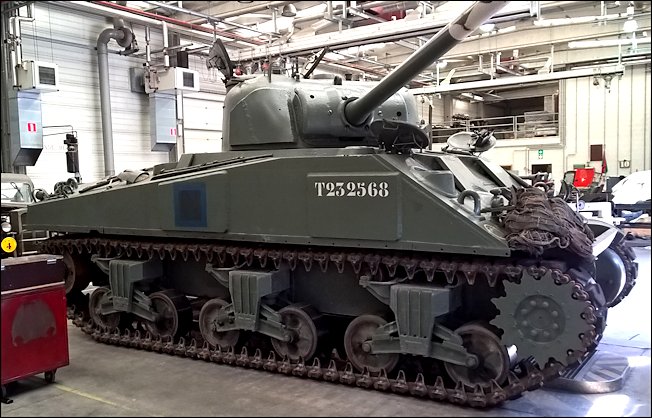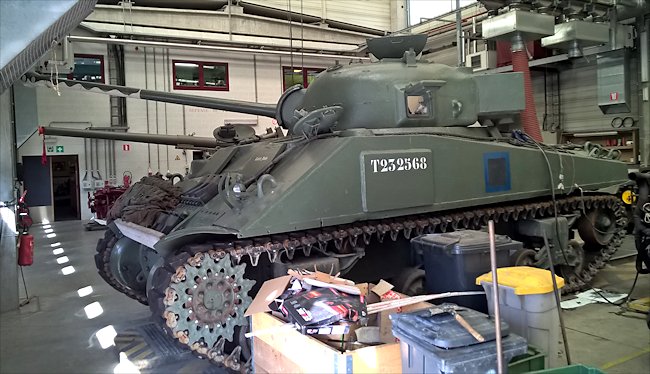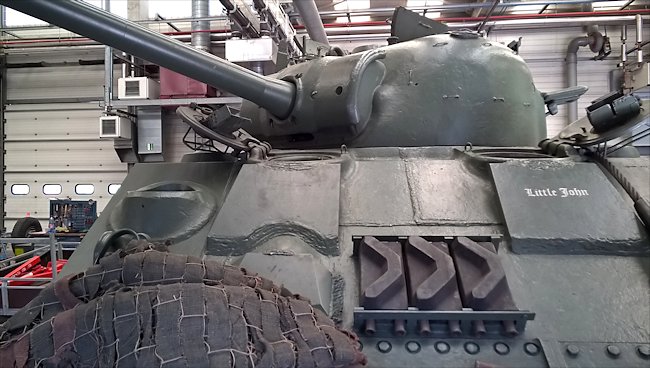Sherman Vc Firefly 17pdr Tank
This Sherman Vc Firefly OQF 17pdr Tank is currently being restored back to a running condition at the Bastogne Barracks Tank Restoration Centre. Its serial number is 5609. British Sherman Firefly Tanks saw action in the WW2 Battle of the Bulge.

This restored Sherman Vc Firefly 17pdr British Tank is exhibited at the Bastogne Barracks in Belgium.
Notice the white paint on the front section of the long 17pdr gun on this Sherman Vc Firefly tank. This was to try and fool the German Panther and Tiger tank crews that the tank had a short barrelled 75 mm gun and could be approached head on and be impervious from any shell that was fired at their front armour. They would get a nasty shock when they were hit by a 17pdr AP armour piercing round from a Firefly. It could penetrate their frontal armour.
It was normal practice for Sherman 17 pdr Firefly tanks to be second in line behind a standard 75mm short barrelled tank using it as both a 'stalking horse' and importantly because the 75mm gun could be loaded to deal with anti-tank guns with HE M48 and the HC M89 smoke shells. Sherman Firefly tanks, until fairly late in WW2, had only AP armour piercing ammunition. The barrel counter camouflage was extremely effective, as at 2000 yards the gunner would be aiming at only the turret or the hull not at anything more specific.
Location
The Bastogne Barracks can be found at 40 Rue de la Roche (N834) in Bastogne just north west of the city centre. They open at 10am and close at 4pm. You really need to get there by 2pm as there is a lot to see. It is an operational military camp with a tank restoration centre attached. You have to wait to go on a guided tour. You cannot wander around on your own. The only day it is closed is Monday. Many of the tanks have been restored to running condition. Have a look at their Facebook page for information about new events.

Notice the white paint on the front section of the gun barrel. This was to fool the Germans to believe that the tank was only fitted with the short barrelled 75mm gun and not the powerful British 17pdr gun.
Specifications
The M4A4 Sherman Tank was powered by a Chrysler A57 multibank petrol engine. The Sherman tank hull had to be lengthened to enable the engine to fit. It produced 470 hp. The tank had a top road speed of 30 mph (48 km/h). It had an operational range of around 120 miles (193 km). The tank had a crew of five, commander, driver, gunner, loader and co-driver/machine gunner. Its armour thickness ranged for 25 mm to 75 mm. Additional plate armour was welded on the front of the Firefly in front of the driver and co-driver's position. Amour plates were also welded to the side of the tanks hull to protect the crew and the ammo storage bins.
It was armed with the powerful British Ordinance Quick Firing OQF 17 pounder long barrelled high velocity gun (76.2mm) that could penetrate the armour of both the German Tiger and Panther tank. It did not have a hull mounted machine gun. A .30cal (7.62mm) Browning M1919 machine gun was installed next to the main gun in the turret. A .50cal (12.7mm) Browning Machine gun could be fitted to a mount on top of the turret.

This restored Sherman Mark Vc Firefly 17pdr British Tank is exhibited at the Bastogne Barracks in Belgium.
Why are there metal rectangles welded to the side of the tank?
Apart from giving the enemy targets to aim at they were designed to give extra protection to ammunition bins and crew members. It was called applique armour. The only down side on appliqué armour was if the shot hit an edge of the plate. As a general rule factory fitted appliqué armour was effective. Added to which the stowage inside the tank was improved by a 6 mm locker being constructed around the all the Ammo storage bins. This was designed to reduced the chances of flash or fire spreading to other ammunition stowage bins.
Irrespective of the type of hull used British conversions of Sherman Mk 1 and Mk V tanks into 17pdr Firefly tanks were done without any regard to what applique armour was originally fitted to the tank. The the first firefly tanks were from mid production Sherman Mk V tanks, many of which had no additional armour on the hull sides but some had the patch on the turret. Later early production tanks were remanufactured in the USA and shipped across to the British so many early model Sherman Mk I and Mk V had the full applique armour kit even though in a 17pdr tank it didn't protect the main armament ammunition stowage area. Sherman Mk I hybrids were the same.
Monty blocks the River Meuse Crossings
At 0200 hr, a sleepy duty officer of the British 29th Armoured Brigade, stationed at Y pres, was roused from his 'pit' by the incessant ringing of the phone. With a curse, he picked up the receiver. With a sudden shock that drove all thoughts of sleep from his befuddled mind, he realized that he was talking to no less a person than Gen Freddie de Guingand, the chief of staff of Montgomery's 21st Army Group. Hurriedly, the young captain pulled himself together and started scribbling down 'a series of orders which came through as fast as they could be noted': 'The brigade will move as quickly as possible ... the brigadier will start at once for Army Group Headquarters in Brussels to receive his detailed orders.'
That was the order which sounded the end of any sleep for most of the 2901 Brigade's four regiments that night. It came not, as of old fort4the cavalry, by means of trumpet, but over the telephone. But where were their steeds? The 29th Brigade's 3rd Royal Tanks, 23rd Hussars and 2nd Fife and Forfar Yeomanry, plus the infantry of the 8th Battalion Rifle Brigade, had just had all of their battle-battered tanks taken from them so that the vehicles could be refitted for Montgomery's coming battle for the Rhineland. Now they were down to a couple of dozen tanks at the most.
This was known to their brigadier, who had gone off woodcock shooting for a couple of days while the 29th Brigade was replenished. Now, alerted to the surprise move, he protested, 'But I haven't got any bloody tanks — they've all been handed in.' The brigadier's suspicion that this could all be a pre-Christmas practical joke soon vanished when he was told in no uncertain terms: 'Get your old ones back — those that are runners.' With these weary old vehicles, all of them outgunned by the enemy, he was to proceed immediately to Dinant on the River Meuse to 'block the passage of at least two Panzer armies'.
Brig Roscoe Harvey didn't know whether to laugh or weep, but orders were orders, Four hours later the first of his 3,000-strong command were heading across a foggy pre-dawn Belgium to the new front.
Read more in these two tank books

